Wall decoration options in the hallway
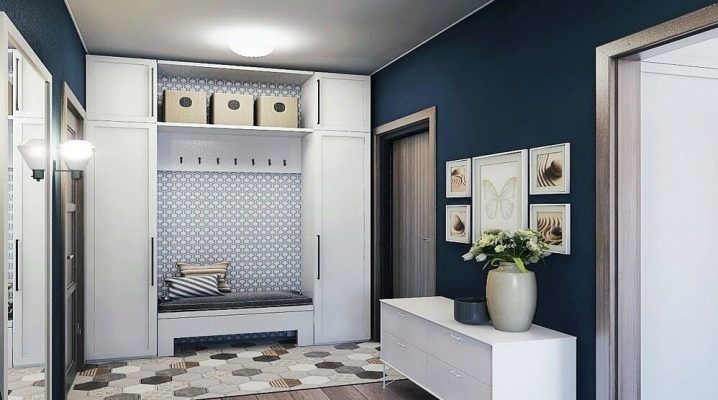
Renovation of the hallway is not complete without wall cladding, which are one of the most vulnerable places in the home. They suffer from mechanical damage, exposure to moisture, water, pollution, as well as from children's creativity or the claws of pets. The choice of finishing material should take into account a number of factors by which the best and most practical option is determined. To do this, you need to study the features and benefits of each type of decorative design of the hallway walls.
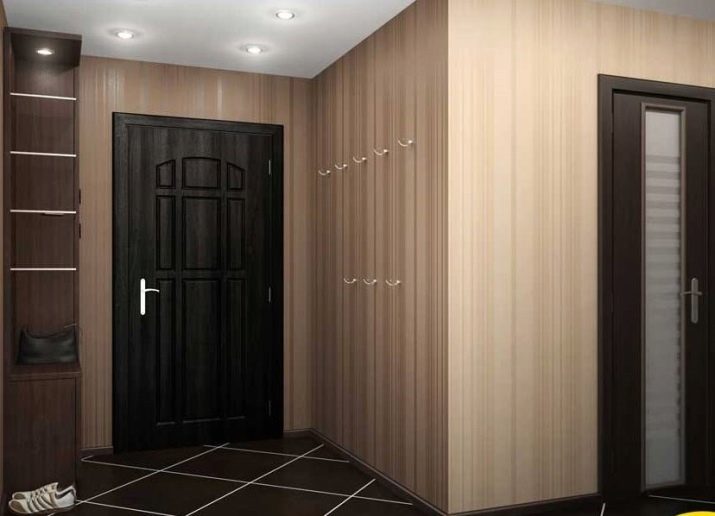

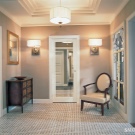
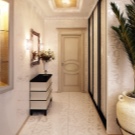
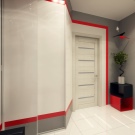
Finishing features
The hallway always speaks eloquently about the owners of an apartment or house. She indicates their taste preferences, demonstrates well-being, often betrays the habits of household members. It is important that this room creates the correct idea, although the possibilities of decorating the corridor are often limited: the room does not have enough illumination, in most cases it does not have enough space, while it must contain the maximum of items necessary for each household. Knowing this, the decoration of the hallway should be special.
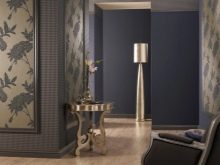
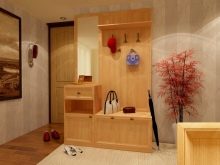
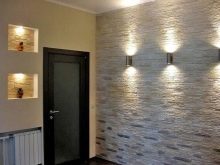
This is not so much a decorative solution as a combination of beauty and practicality, a decoration tool that changes the aesthetic perception of space.
The hallway decoration is functional, its main tasks are:
- unobtrusive organization and division of the area into separate functional zones;
- maintaining the practicality of the walls through the used raw materials that are resistant to regular maintenance (including detergents);
- visually increasing the space, presenting it in a favorable light;
- distracting attention from the unsightly design features of the room;
- demonstration of stylistics compliance with current fashion trends;
- creating an atmosphere of home comfort.
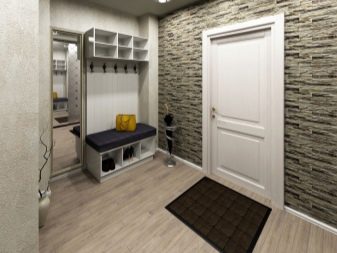

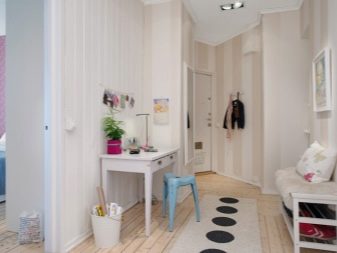
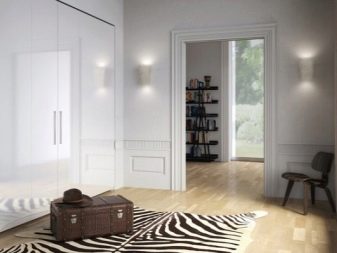
The facing material used in the decoration of the walls of the hallway is diverse. Due to the wide assortment presented for sale by eminent brands, the cladding has a lot of advantages.
Depending on the type of material, the amount used, it:
- manufactured using modern technologies on professional equipment, which increases the quality and practical characteristics of each type;
- in any line it has a lot of collectible materials, through which you can convey the uniqueness of the texture, its relief, relevance in a specific style;
- has a wide choice of color solutions, allowing the harmonious blending of materials into any design technique;
- allows you to decorate the walls with modern materials, while choosing any historical period, bringing the necessary notes into the atmosphere of the hallway;
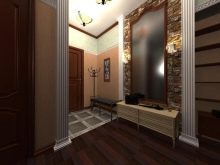
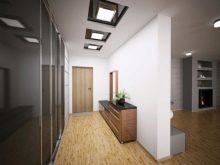
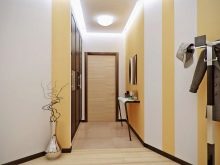
- is able to visually increase the height of the walls, expand them relative to each other, align the broken perspective, change the temperature background of the room;
- due to the methods of combination, it allows you to save on the purchase of material, allowing you to use the remnants of the cladding in the decoration after finishing other rooms of the dwelling;
- can be performed in any contrast technique, combining materials of different texture and composition in the decoration;
- due to a wide selection and different composition, it differs in price, which makes it possible for each buyer to finish the walls of the hallway with the material they like, taking into account taste preferences and the budget available for the purchase.

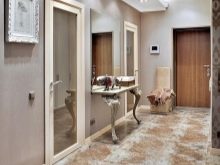
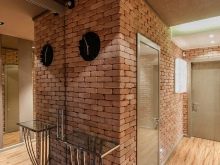
Decorating the walls of the hallway allows you to express yourself, reveal your creativity. It is a way to create positive emotions when entering any home. A distinctive feature of the cladding is the ability to do it yourself. Today, almost every head of the family can do this: manufacturers offer convenient finishing methods that seem complicated only at first glance.
In most of them, the materials are easy to work with, not capricious in care, it is pleasant to work with them, and the result is pleasing to the eye. This eliminates the need to call repair teams, which often spoil the material and the appearance of the finish, blaming poor performance on raw materials deficiencies.
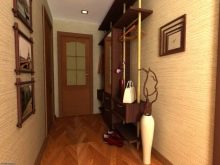


With a lot of advantages, finishing materials have disadvantages, they are:
- almost always give out the cost of raw materials, so they need the right approach to the choice;
- regardless of the variety, they compare all the furnishings with themselves, forcing the furniture to correspond to the desired level;
- in any category, they have a classification, among which the budget varieties are the weakest and most impractical;
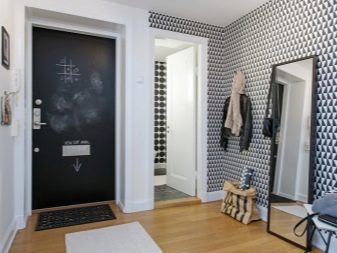
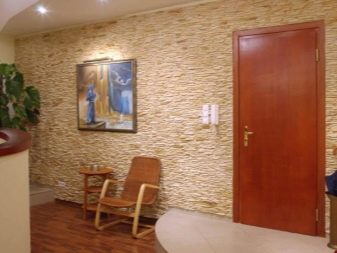
- based on the shortcomings of the usable area, they are limited in the choice of dark shades that conceal the degree of illumination of the room;
- cannot be completely lined with light tones, since they are impractical, they get dirty and yellow over time;
- limited in the use of large prints of textures or patterns, if the space of the room is insufficient;
- in premium lines it is not always affordable, since they require replacement of existing furniture at the same time as wall cladding.
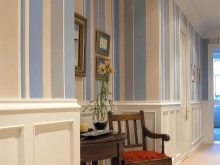
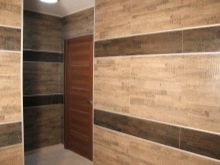

We take into account non-standard forms
In the decoration of the hallway, design features are of primary importance. Often the space is non-standard, it can have narrow doorways, uncomfortable doors. Some types of rooms are combined, so the hallway must be separated from the living room. Sometimes the border of two rooms is a small partition or the hallway does not have a corridor. Other rooms have a slanted perspective, which makes design difficult.
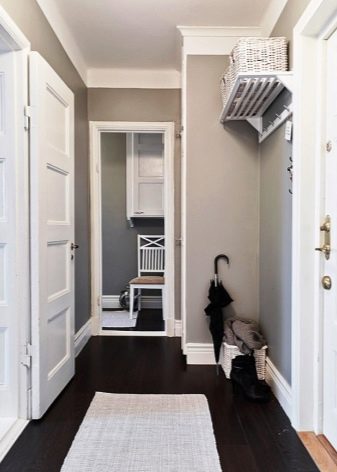
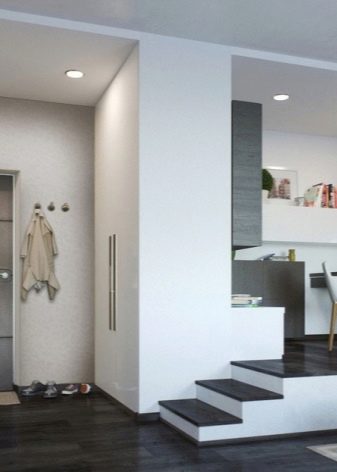
When finishing, any detail of a non-standard shape is taken into account. For example, in the long hallway of the Khrushchev and the spacious studio apartment, the wall cladding is radically different. In the first case, it is important to expand the area, in the second, it is worth zoning the space, giving it an organization. Of particular importance are arches, ledges and niches, which make wall cladding difficult and require the correct placement of accents so as not to get lost in the general background. In such cases, you have to combine the material in order to simplify the finishing work.
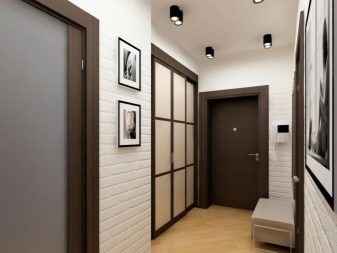
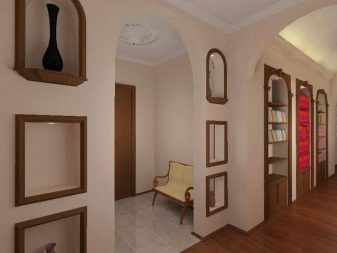
Decoration Materials
The construction market offers a lot of finishing materials that are applicable in the decoration of the walls of the hallway. This can be clapboard, leather trim or more creative covering, as well as wall decor in the form of stickers. To date, there are 9 varieties of finishing materials that are in demand in the decor of the walls of the hallway, these are:
Dye
A universal budget trick that anyone can use without special skills. This material means three types of paints: latex, acrylic and water-based. They are easy to work with, fit well on the surface prepared for painting and reduce the time for wall cladding. The disadvantages of painting are the need to dry the painted surface and an unpleasant odor, which can provoke an allergic reaction in sensitive households.
It is important to consider: after painting, the first time you need to protect the surface from mechanical damage.
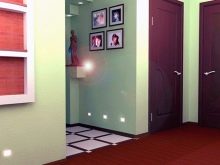
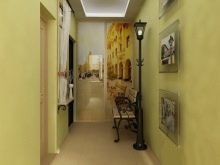
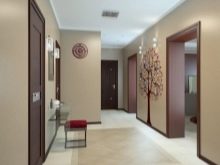
Decorative plaster
This finish is notable for its practicality and convenience, with an original embossed surface.It is easy to clean, allows the use of wet sponges for cleaning the surface, is characterized by granularity, is harmless to health and is durable in use. Decorative plaster has air permeability, harmoniously fits into various stylistic directions, has a wide range of textured techniques and colors.
The material is picky about the preparation of the base, it does not look impressive if the surface of the wall is curved. In addition, a professional, stylish cladding effect is within the power of a master with a certain experience.
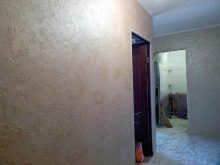

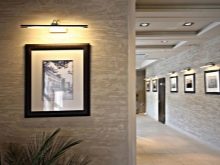
Microcement
The main component of the raw material is a mixture based on polymers and cement with an admixture of coloring pigments. This is a versatile cladding that fits perfectly on different wall bases (concrete, wood, metal). It can have a different structure, have a relief, be smooth or rough, while resistant to the claws of pets. At a price microcement is cheaper than plaster, which saves the family budget.

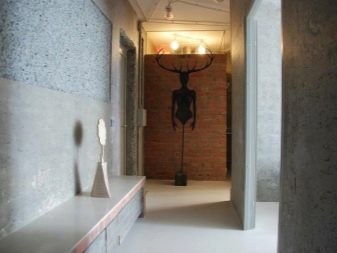
Wallpaper
Wallpaper is a classic design technique, allowing you to combine with each other and play on the imperfections of space by the correct placement of accents. The lines include roll, powder and "wet" wallpapers with a variety of textures, through which you can smooth out minor irregularities in the walls and ceiling, strengthen the walls, make them warmer, and save the room from unnecessary noise.
Wallpapers are distinguished by a huge selection of patterns, indicate any idea and design premium, demonstrating the delicate taste of the owners of the house. Different series include paper, vinyl, non-woven, textile, liquid wallpaper, photo printing, glass wallpaper that can be painted about 20 times, cork and bamboo varieties, canvases with a three-dimensional 3D image.
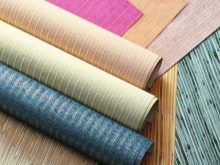


Wall panels
This cladding includes materials from wood, plastic, glass, plasterboard, fibreboard (MDF). They wash well, do not require a perfectly flat wall surface for installation, hide problem areas of planes, are simple and quick to install and dismantle. Wall panels look stylish, beautiful and fashionable, they often imitate the texture of wood, brick, tile and masonry. They can be installed in place of wallpaper, using raw materials in the form of slats, tiles or sheet material, hiding the joints and seams with moldings. They serve up to 15 years, are resistant to mechanical damage, and can be placed on the walls vertically, horizontally, at an angle.
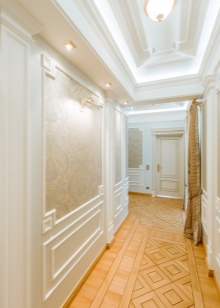


Laminate
This finish is an alternative to wall panels. The material looks beautiful, stylish and expensive, is able to imitate a variety of textures, is easy to install and dismantle. Its surface is smooth, easy to maintain, reliable and aesthetic, does not require preliminary preparation of the base.
But this cladding is inappropriate in rooms with high humidity: the back of the laminate absorbs moisture, which leads to deformation of the finish, the formation of waves and soaking, which cannot be eliminated.
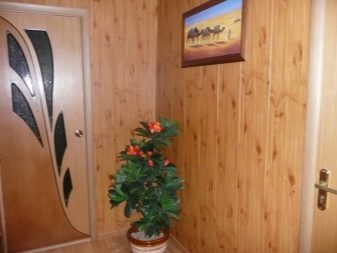
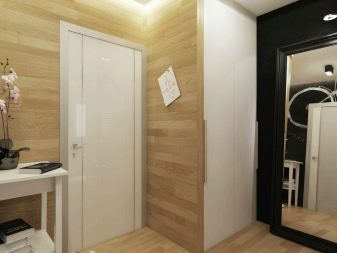
Fake diamond
Wall decoration with decorative stone is an expensive type of hallway wall decoration. Its aesthetic properties and durability are quite high. The basis of the material is gypsum, so this finish is recognized as environmentally friendly. More often, the stone is placed at the bottom of the hallway walls: in places most susceptible to mechanical damage.
Such cladding is durable, differs in relief, provides for painting and correction of damaged areas, which is extremely rare. Laying is carried out exclusively on a smooth and even surface.
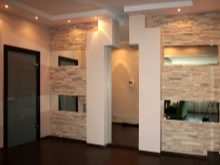
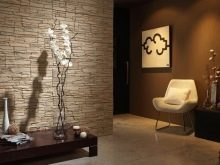

Tile
One of the universal techniques for wall cladding, characterized by moisture resistance and economy. The tile withstands any cleaning, is a practical material, easy to use and affordable in price, it has a long service life, a lot of different patterns in different shades.In terms of performance, it is better than wall panels, does not change properties in any type of room, regardless of temperature changes or degree of humidity. The brightness of the shades does not change over a long period of time, the pattern is not erased from the surface.
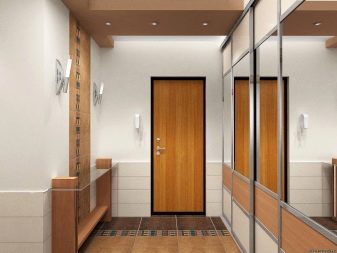
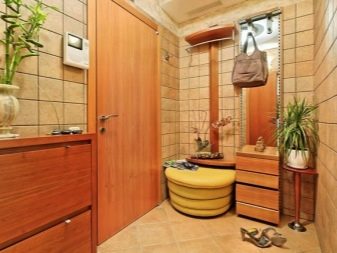
Fresco
This finish looks rich and unique, indicating the special taste of the owners of the house. It is an elegant type of wall decor that is difficult to decorate and has a high cost. The material has a base in the form of non-woven fabric, synthetic materials and inclusions of plaster, marble chips. It is distinguished by the visibility of an aged surface in the form of cracks, textured chips.
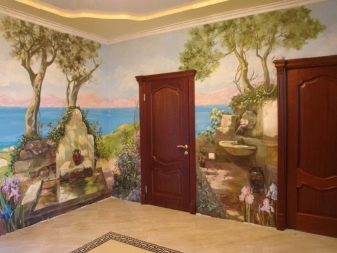
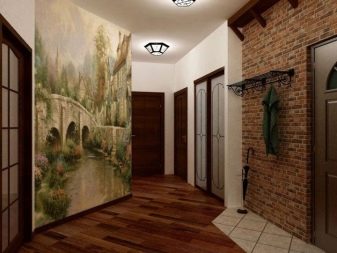
Niche design in the wall
Niche decoration depends on the overall design idea. At the same time, it can be decorated to match, or it can have a contrast to the main or accent finishing cladding. Its finish depends on the type of surface and almost always emphasizes the presence, thereby giving the niche special significance as a functional and decorative element of the interior. In addition to the decoration itself, the niche is often decorated with lamps, complementing the central lighting, regardless of the rectangular or arched shape. If the space of the room is sufficient, the niche is a kind of mini-exhibition, demonstrating the style, decorating with figurines, paintings, frescoes.
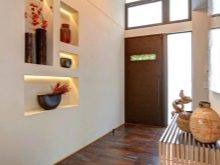
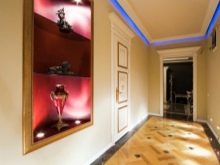
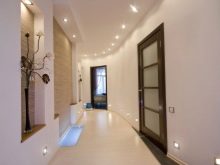
It is easier to paint it in any color; in other cases, the design technique involves a combination of surface painting and wallpapering the walls. Often, a bright accent in the form of a panel or picture is glued over the location of the niche.
Each technique is subject to the rule of combining texture, shade, theme of style. Designs often involve glass and moldings.
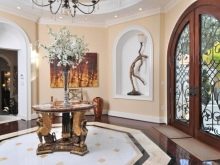
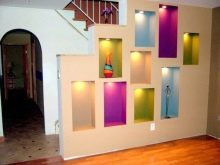

Choosing the color of the finish
Everyone's color preferences are individual. In the hallway, it is not customary to fill the space with white: it is good in the picture, but in fact it is not at all practical. It is better to choose light spots that increase the area in shades of beige. At the same time, it is better if the shade is matte and warm: cold tones do not set you up for a positive, they add gloom to the interior.
The priority is given to delicate peach, coffee, nude and bronze tones, made in contrast to gold, silver and white decor, a shade of bleached wenge oak.
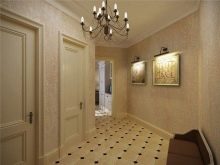
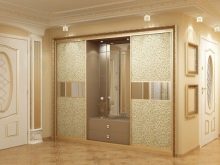
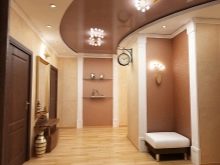
It is better to avoid dark and aggressive colors: they change the aesthetic perception of the hallway for the worse. Purple, red, blue paints are unacceptable. If you need brightness, you should pay attention to woody tones, coral, sandy yellow, pink, olive, terracotta, brick colors of the color palette. Monochrome combinations should be avoided: they are inappropriate in this finish.
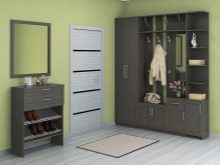
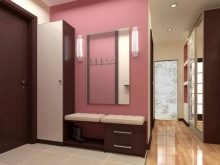
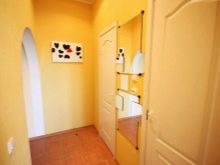
Wall design options and decor
The hallway is the place where it is best to apply design combination techniques in the design. This will allow you to beat the imperfections in space and use the cladding material in accordance with the zones of different degrees of stress. You can decorate the walls with your own hands, if necessary, giving the space the desired tone and mood. To make the design beautiful, you need to prepare a sketch, indicating the places of decor.
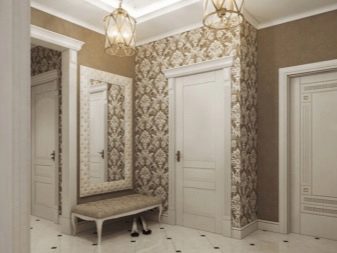
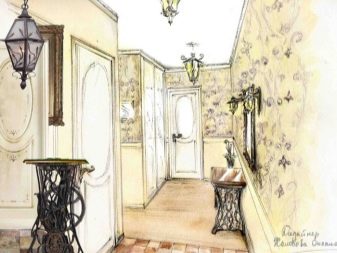
After drawing up a rough plan, material is selected. More often it is a combined finish, with the help of which it is easier to decorate the walls of the hallway. For example, it can be a combination of tiles and laminate, panels that make it easier to sheathe walls, make corners, and wallpaper with which you can paste over the top of walls or certain ledges. You can decorate the walls with the help of pictures, a pattern lined with liquid wallpaper or decorative stickers, gluing them over the facing material.
This technique is especially relevant when combining cladding: this way you can combine different materials together.
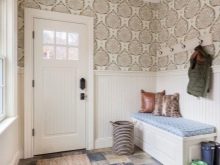
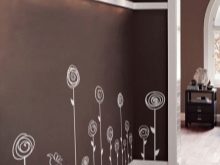
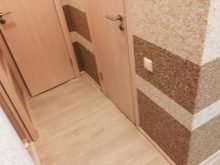
Taking as a basis the laying of stone or plaster, you can use different techniques. For example, use stones brought from travel, rhinestones, glitter in the facing.The relief pattern of the surface can be created with a spatula, a kind of painting with fingers or using special stencils. Sometimes coins, fragments of fabric, metal and glass plates are added to the relief. It is better to decorate the panels with moldings or a baguette.

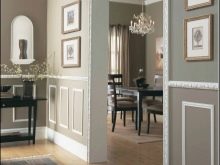
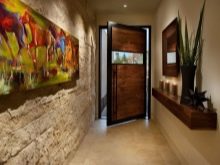
Interior arrangement
In addition to the choice of finishing material, furnishing elements, including small accessories, are of great importance. Everything should be functional and aesthetically pleasing to the eye. You cannot do without shelves for shoes and hooks for outerwear if the space of the room is small. If space permits, you can hang pictures on the wall or decorate the ledges of the walls with indoor plants. If the space is very large, you can place a wall table along the wall, decorating the tabletop with decorative figurines, fresh flowers, shells or unusual lamps, creating an interesting color composition.
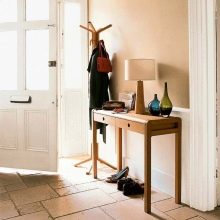
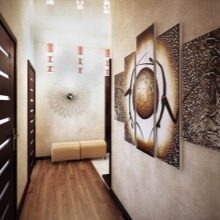
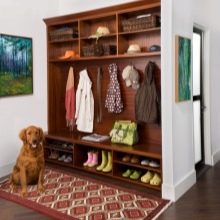
It is advisable that in the hallway there is a wardrobe with a mezzanine and drawers. This will allow you to accommodate a maximum of clothes for each season, remove items that are needed from time to time. It's ugly if the walls are empty: you can decorate them with wallpaper panels, frescoes, mirrors, built-in lighting. If the hallway is large, a narrow sofa located along the wall is appropriate.
For practicality, the sofa can be packed in a removable Euro cover that fits the furniture from all sides, providing for easy cleaning and washing.
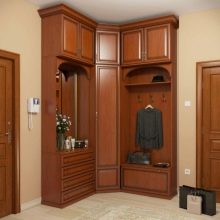
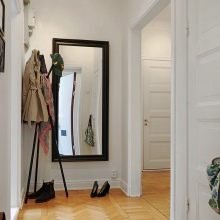
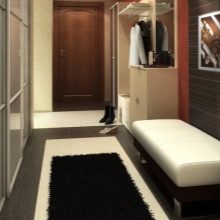
Modern design ideas
To visually have an idea of how to decorate the walls of the hallway, you can refer to the examples of experienced designers:
- a narrow corridor can be decorated with wallpaper with a medium-sized pattern, hanging pictures on the walls, and sheathing the bottom of the walls with panels: in this case, it is better to choose doors and furniture in light colors;
- if the space is minimal, you can designate it with tiles with a practical lace pattern that emphasizes the color of the doors, shelves, hooks for clothes, placing a pouf for changing shoes and a shelf for shoes at the threshold;
- in a hallway with a lot of ledges and a minimum of space, you can simply paint the walls in a calm color by hanging several framed photos on them, decorating the ledges with statuettes and deliberately highlighting them with light;
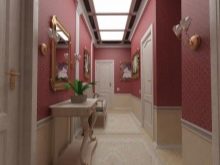
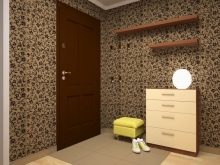
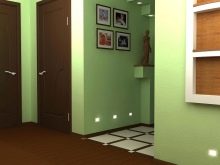
- an interesting look of the hallway can be created using panels in beige and brown tones, sheathed the wall with them horizontally, installing a wardrobe for clothes near the door, laying a rug for shoes and hanging an unusual lamp on the wall at the entrance;
- you can combine walls with plaster and volumetric frescoes and imitation of masonry, partially sheathing the corners with them, thereby accentuating the doorway and mirror;
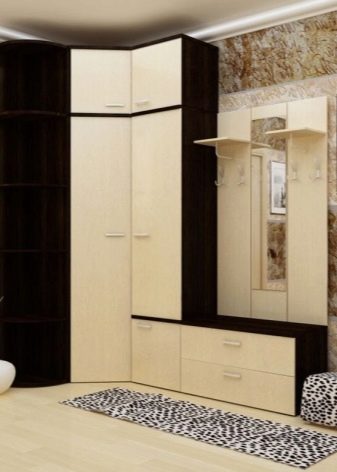
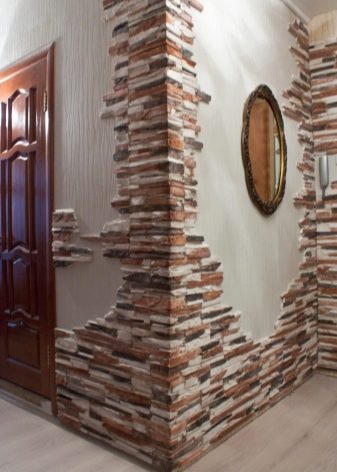
- the textured finish of a beige shade in combination with plain brown doors, a large mirror, spotlights and wall sconces with forged decor looks beautiful on the walls of the hallway;
- in a room with a broken perspective, you can highlight the wall with panels, combining them with an accent wallpaper decorated with lighting and a shoe shelf: this makes it easier to divert attention from the diagonal walls of the room.
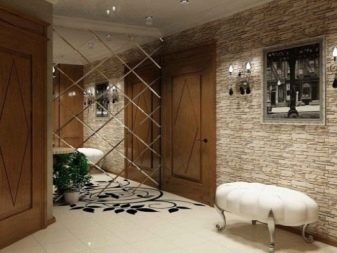

See below for more details.













The comment was sent successfully.